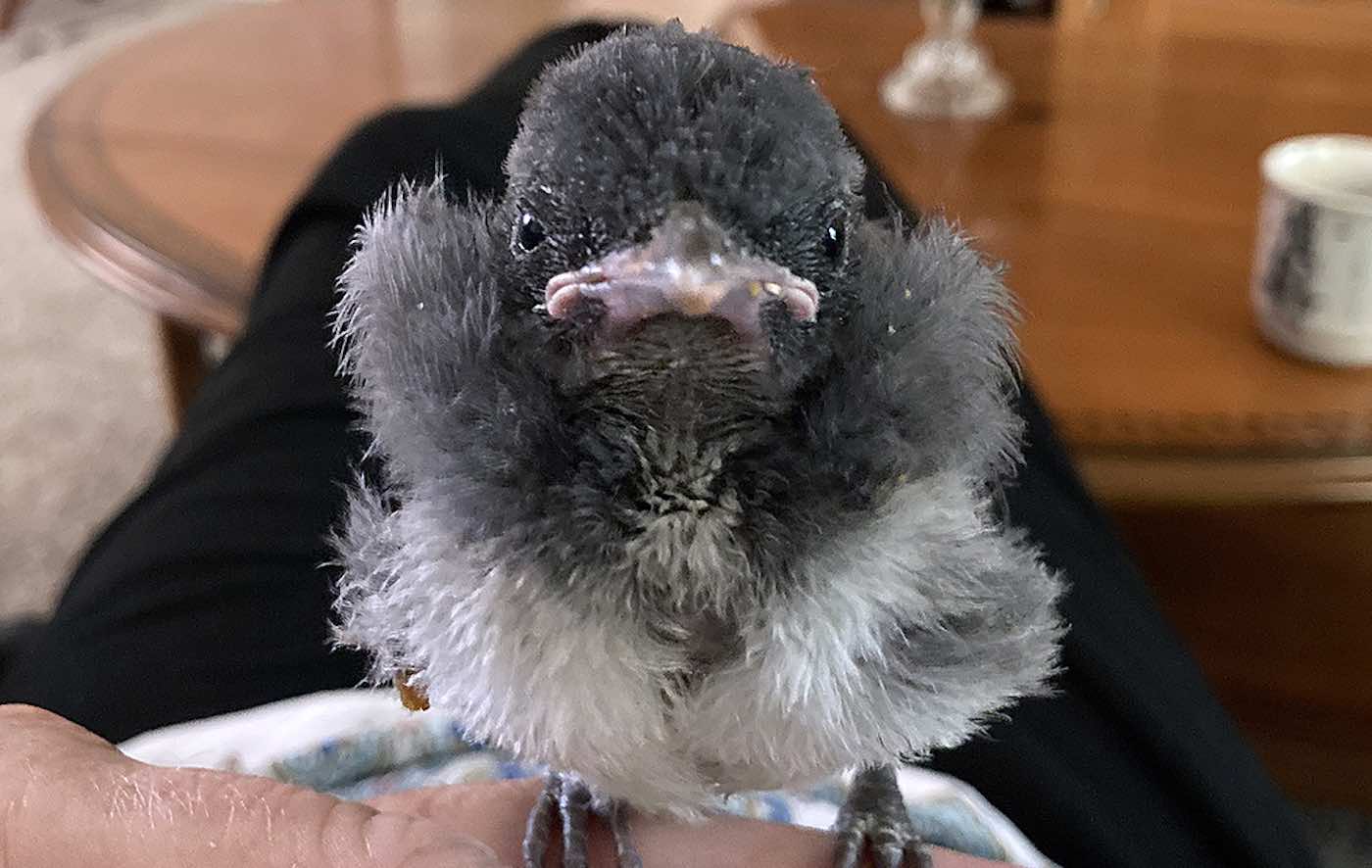[By USACE]– Temperatures were pushing 100 degrees in East Sacramento on July 9. Still, U.S. Army Corps of Engineers Sacramento District’s contractors and construction workers made steady progress on the Sacramento River East Levee project, until a contractor noticed something out of place.
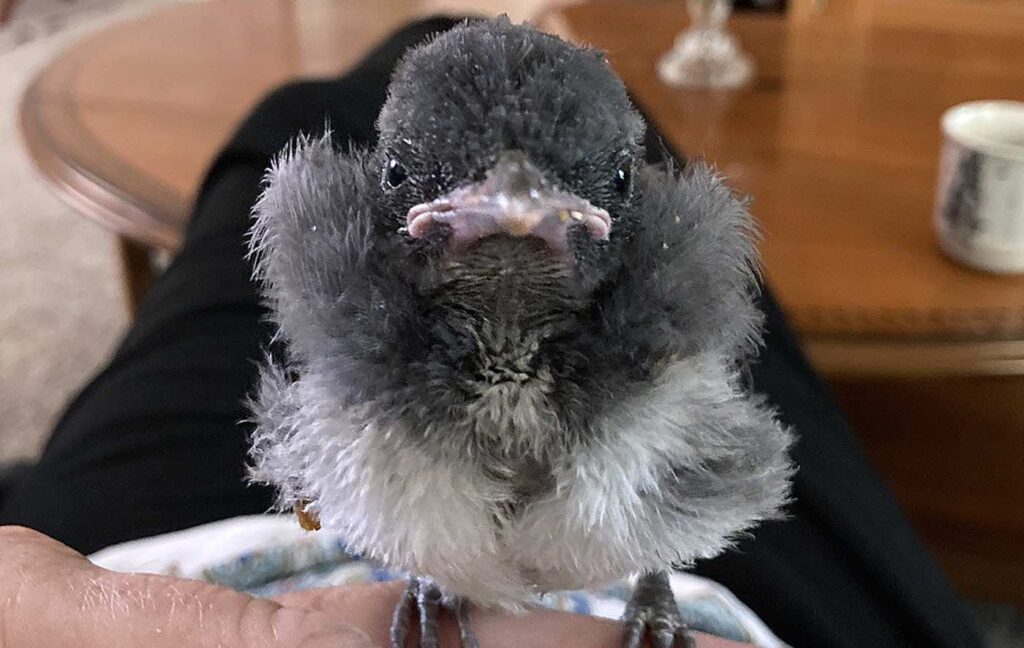
Among the bustle of activity, contract worker Roberto Navarez spotted two gray, baby birds sitting on the levee, right in the path of a massive bulldozer shoving along a mound of dirt. He noticed several long branches from a huge oak tree stretched over the levee, but he couldn’t see a nest anywhere in the tree.
Assuming the chicks had fallen or jumped out of their nest, Navarez continued to watch the pair, hoping they would soon be rounded up by their parents. Unfortunately, neither the mother nor father bird appeared.
With construction equipment rumbling past and the mid-day heat now topping 104 degrees, Navarez knew the chicks needed to be moved out of harm’s way, and fast. Feeling apprehensive about moving them himself, he reached out to wildlife biologist Pete Morris of Nordic, the SREL Contract 2 project contractor.
Arriving on scene, Morris observed the birds and decided the pair of chicks must be taken out of the withering heat if they were to have a chance of survival. He then retrieved a small cardboard box, and the two rogue chicks were gently scooped up and taken back to the Army Corps of Engineering (USACE) trailer.
Once inside the air-conditioned building, the larger of the two chicks immediately managed to get out of the box and began hopping around, interacting with rescuers and “chirping its lungs out.” The smaller sibling, however, seemed to be struggling. It remained quiet and listless, hunkered down in the makeshift nest.
Unsure of what to do next, someone brought up the name of Lee Roork. Working on the levee as a Quality Assurance Representative for USACE, Roork was known to be an avid birder. He could often be seen on his breaks or at lunchtime checking out birds and nests with his binoculars. Roork had also been known to take injured owls or hawks to various wildlife sanctuaries around Sacramento in the past, so he seemed the right person to contact.
POPULAR: Dog Missing for Weeks Wanders Into Walmart and Finds Owner Working at the Register
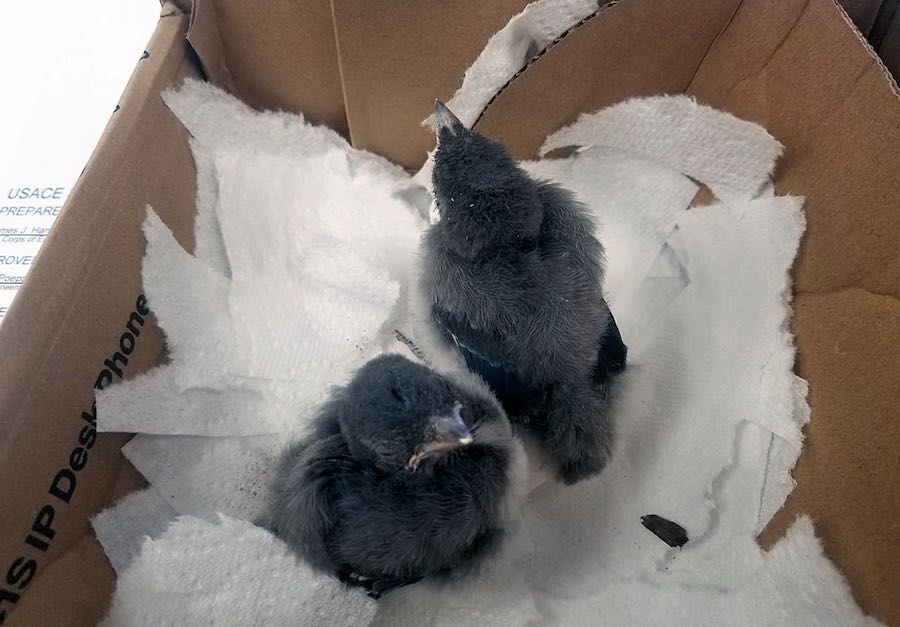
Roork knew the ideal fix was to return the wayward chicks back to the tree they had fallen from in hopes that one of the parent birds would return to collect them. He mashed up some blackberries and seeds, providing some nourishment for obviously ravenous babies, then returned to place the box and birds back in the tree. But as soon as the cardboard “nest” was attached to a branch, the larger of the two chicks leapt from the box. An adult scrub jay immediately swooped down and started interacting with the chick as both hastily scampered into nearby brush.
As Roork returned to work, the smaller, weaker bird remained in the nest, but Roork wanted to give the parent birds time to return and take care of their baby. He said he made intermittent checks throughout the rest of the day, but found that neither parent would go near the “nest” containing the abandoned baby Jay.
By the end of the business day, it was looking pretty grim for the lone nestling, said Roork.
“I was certain the little bird wouldn’t survive another 24 hours unless someone helped it. It was in pretty bad shape, so I decided to try to help it, rather than leave it to die,” said Roork.
He then sent a one-sentence text to his wife, Susan Roork (also a USACE employee, who was teleworking from home not far from the SREL site). “Want to raise a baby scrub jay?” the text read.
Susan, an animal enthusiast who also has plenty of experience with rescues, sent back a one-word response … “Definitely!”
Susan went into research mode, scouring bird rescue sites for pertinent information and discovered that scrub jays eat everything from soft cat food and meal worms to local berries, fruits, and seeds. What they never did discover was whether “Blu Blu” (the name that stuck) was a male or female.
“Their coloring and markings look extraordinarily similar,” said Susan.” So, we just went with ‘her’ most of the time.”
A bigger question remained, however: would Blu even pull through? For the first 24 hours, Blu barely moved. She sat limply, hunkered down in her newly created home-nest. But by the second day, Susan was able to get some food and water into her.
The transformation was incredible.
LOOK: Firefighters Get Creative to Help Baby Raccoon With its Head Stuck in a Sewer Cover
“She started wholeheartedly interacting with us, eagerly taking water through a little hypodermic dispenser, gobbling down healthy portions of food, acting alert, responsive and curious – she was making her way,” said Susan.
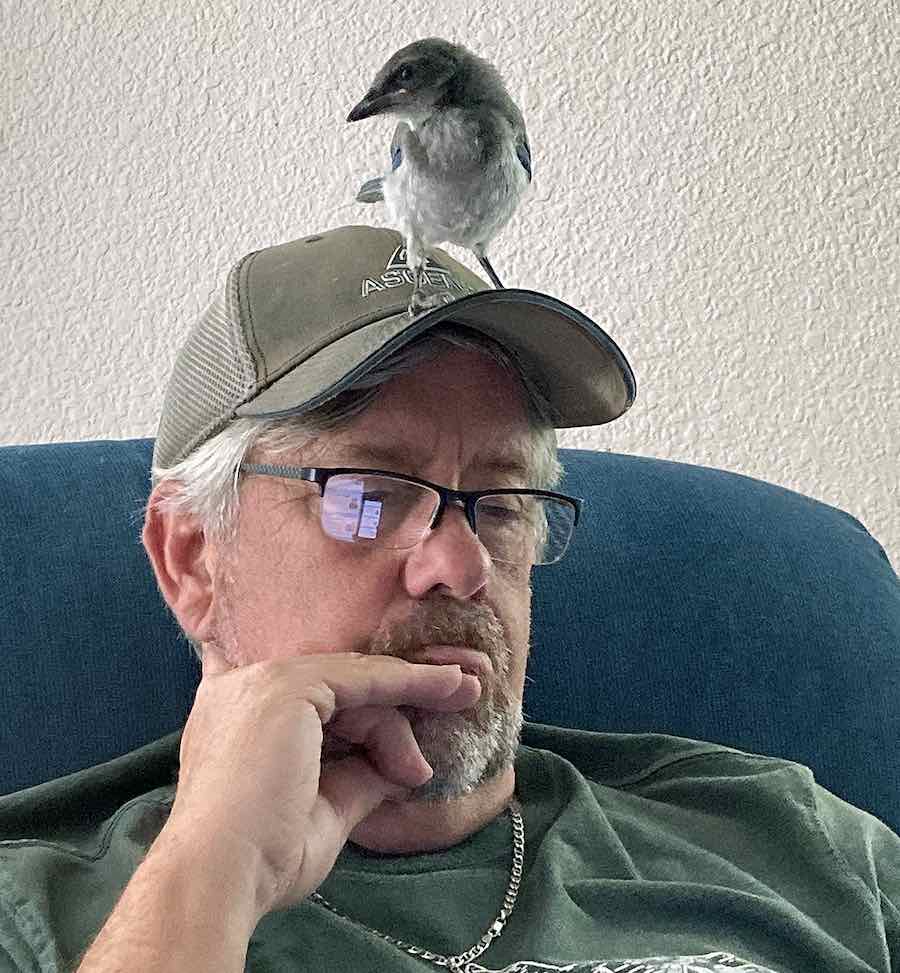
From that point on, Blu’s future never seemed in doubt. She continued to grow stronger, increase in appetite and grow faster than Susan and Lee thought possible.
“We were absolutely amazed by how quickly she grew,” said Susan. “We would go to bed and when we’d check on her the next day it was like looking at a new bird – feathers appearing where there were none before, her tail feathers would be an inch longer, her feet and little talons growing fast.”
RELATED: Clever Cockatoos Craft 3-Piece Tool Set to Extract Fruit – Becoming Only 4th Animal Species to Do So
From the very beginning, Susan, Lee and their teenaged daughter, Jillian, approached taking care of Blu with an end goal in mind – releasing her back to the wild. To do so, they tried to nudge Blu into doing things it would have to do in the wild, such as finding its food, cracking nuts, capturing flies, and building her flying prowess. But they also found that Blu had many of these traits ingrained in her DNA, and she quickly began taking food and hiding it in various locations inside the house for eating later.
“Our biggest concern was whether Blu would be able to learn all the things she would need to survive out in the real world,” said Susan. “We felt that it was important to make sure she had challenges and tasks to figure out, as she would when we released her, so we regularly came up with problems for her to work out. We were always amazed at how quickly she figured out each one and mastered the skills involved.
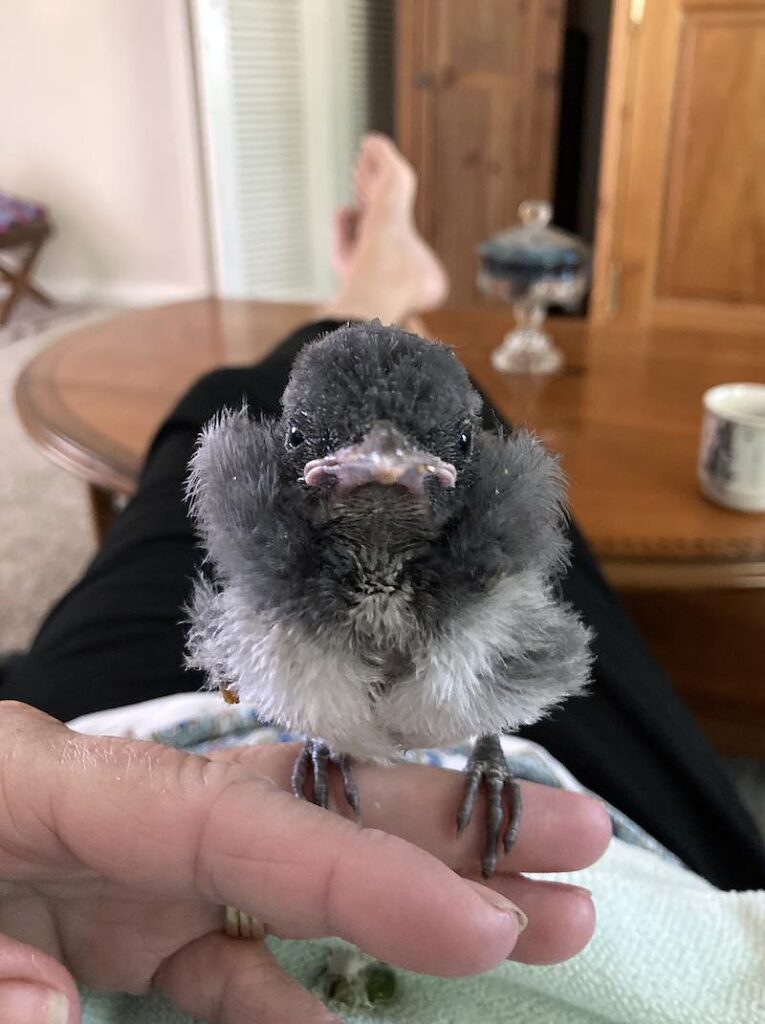
In the first weeks, little Blue was literally Susan’s pet project. As Lee worked on the levee, and Jillian attended school, Blu was teleworking with Susan, pecking at the keyboard to help her type, hopping about and creating mischief – along with the occasional typo – tugging on her earrings, flitting about, stealing sticky-notes … only to suddenly snuggle into a ball of fluff, falling asleep on her wrist, or snuggling warmly against her neck.
LOOK: Orphaned Polar Bear That Loved to Hug Arctic Workers Gets New Life
“Blu had become a great companion, and I knew I would miss her dearly when we released her,” said Susan. “But even though we had all become very attached to Blu and loved the experience of raising her, the ultimate plan to release her was not in question.”
With two months of the Roork’s care, Blu’s transition was stunning. As of late August, she had made the full transition from a chick on the edge of death to a strong and smart scrub jay ready for the great outdoors. Blu had attained expert aerial acrobat status, regularly zooming throughout the house, finding stashed peanuts, catching flies in mid-air, messily bathing in a blue frisbee, and generally acting like an adult bird. And she was spending more and more time staring out the window …
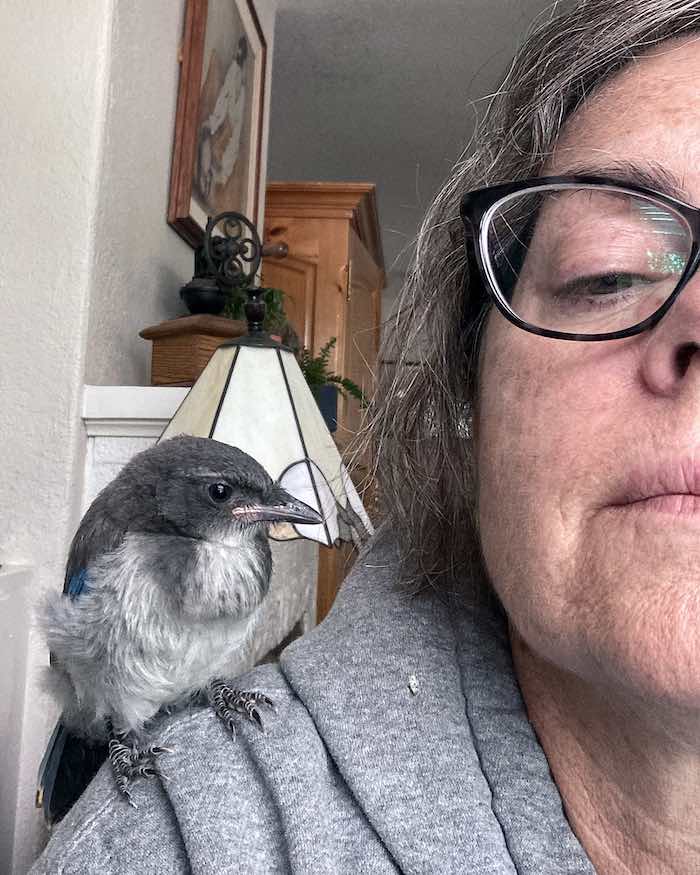
Recognizing Blu’s progress, Susan and Lee decided that Blu’s launch-to-nature date would be over the Labor Day holiday. And even knowing from the start that they would give Blu her freedom to fly, both admitted that they were entirely smitten by the feisty, feathered creature.
“For a brief moment, we considered turning our large chicken coup into a bird sanctuary for her … but we knew it wouldn’t be fair,” said Susan. Lee quickly agreed.
They planned to take Blu’s dog crate-sized sanctuary into the backyard, sit with her for a while, let her acclimate to being outside, and, when they could finally swallow their doubts (and their hearts), they would open the door and see if Blu was ready for the big blue sky.
Then, just as unexpectedly as the little bird had come into their lives, Blu was gone. During a visit from a neighbor, Blu made the decision for all involved, and darted through the slightly opened front door and into nearby trees. She squawked and fussed at Susan for a few moments, but continued to move from tree to tree, getting further and further from the house. Finally, Susan saw Blu join some other scrub jays and begin flying along with them.
POPULAR: Folks in New Jersey Are Caring For More Than 800 Baby Turtles Rescued From Storm Drains
“Even though the plan was always to release her, we were both heartbroken. But only because we were disappointed we didn’t get to make it an official goodbye,” said Susan.
Still, despite the way it ended, both Susan and Lee said it was a wonderful, once-in-a-lifetime experience.
“This has been a unique experience to say the least,” said Lee. “I would never have brought this baby bird home unless I truly believed it was not going to make it. I had no idea how demanding these little guys could be and how much care they need. But I do believe we have done what we could to help her survive in the wild.”
Offering a bit of closure, Blu returned to some trees alongside the Roork’s home shortly after her departure. Susan said they had a final “conversation,” as Blu jumped from branch to branch, excitedly chittering and shadowing them as they walked down the street.
– By J. Paul Bruton, US Army Corps of Engineers – SACRAMENTO DISTRICT




















